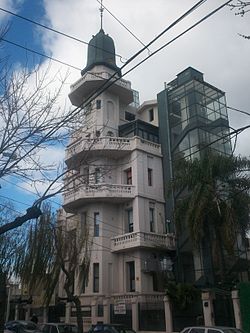Villa del Parque (Buenos Aires)



Villa del Parque is one of the 48 Buenos Aires neighborhoods and is part of Commune 11 of the Autonomous City of Buenos Aires.
Located northwest of the city, it is delimited by the streets Av. Francisco Beiró, Av. San Martín, Arregui, Gavilán, Av. Álvarez Jonte, Miranda and Joaquín V. González. It borders the neighborhoods of Agronomía to the north, La Paternal to the east, Villa General Miter and Villa Santa Rita to the south, and Monte Castro and Villa Devoto to the west. You can get there via the San Martín Line (Villa del Parque Station) and numerous bus lines, such as 24 47 80 84 105 109 110 124 134 135 146
History
The neighborhood was officially founded in 1908. It is located on the territory of what was the Chacarita de los Colegiales, in the first instance populated by Jesuits, and with their withdrawal in 1767, the entire area It was covered with weeds and changed owners on several occasions, reducing the size of each plot more and more until 1893 when the Parks and Walks Commission asked the Municipality to obtain the transfer of 100 hectares to form the "Parque del Oeste".
In 1901, the Executive Branch resolved to improve agricultural education, until then limited only to the Faculty of Agronomy and Veterinary Medicine in La Plata, to create an Agronomic Station with a Model Farm and Practical School of Agriculture. That project was approved in 1903.
In about fifty blocks the current neighborhood was developed, which at that time received the name "Happy City", although later due to its proximity to the Agronomic Park it was called & #34;Villa del Parque'.
Finally, on November 8, 1908, the neighborhood was officially founded in the City of Buenos Aires. Among the buildings that stand out there are the mansion known as the Palace of the Bugs and the Santa Ana parish, located in front of the San Martín Railway station.
In the beginning it was barely urbanized, but gradually several villas were built in the area. The first of them was that of Don Antonio Cambiasso, whose current location coincides with Campana Street.
Neighborhood life
The 'Aristóbulo del Valle' square, Cuenca Street and the railway station are the center of Villa del Parque. The Cuenca parade is traditional during the Buenos Aires carnival, with the murga 'Los Pitucos de Villa del Parque'.
Two blocks from the railway station is the Gimnasia y Esgrima de Villa del Parque club, an emblematic club of the neighborhood that plays in Level 1 of metropolitan basketball (FeBAMBA).
In front of the square, on Marcos Sastre Street, is the Parque Club (participant in the 2nd Division of Argentine futsal), from whose children's soccer department emerged numerous professional players of great national and international importance, including them Juan Pablo Sorín, Esteban Cambiasso, Carlos Tévez, Fernando Gago and Federico Insúa and where Diego Armando Maradona also once played.
A few blocks away, at Nogoyá 3045, stands the Capital Federal headquarters of the Racing Club, a space for important sports and cultural activities in the neighborhood and surrounding areas.
As for fans and sympathizers of soccer teams, Villa del Parque identifies with Club Atlético All Boys and Argentinos Juniors. For the past few years, fans of San Lorenzo and Racing Club de Avellaneda have also gathered before games.
The Cultural Association and Popular Cultural Library Roffo stands out, located at Simbrón 3058 and the Popular Library of the Neighborhood Association (Baigorria 3373). Multiple cultural activities take place in both. Another iconic symbol of the neighborhood is the Communications Club, with its famous carnival parties, in which renowned musicians and singers, Argentine and foreign, participated. In addition to being a meeting point for families and young people, Comunicaciones is one of the clubs that offers the greatest variety of sports, within the Autonomous City of Buenos Aires. In addition, the neighborhood has different artistic expressions, among which El Centro Murga, Los Pitucos de Villa del Parque and Villa Devoto stand out, created in May 1998 wearing violet, orange and white colors, they rehearse on Saturdays at R. Gutiérrez and E. Lamarca, and since 2008 for February, more precisely on the Carnival holiday, organizes the mythical Corso de la calle Cuenca (Cuenca and Marcos Sastre).
Famous neighbors
The writer Julio Cortázar, the musicians Andrés Ciro Martínez, Horacio Salgán and Sebastián Piana lived in Villa del Parque, the tango singer Julio Sosa on 2400 Helguera Street, the actors Guillermo Francella, José María Listorti, Luciano Castro, Lorena Paola and Pedrito Quartucci, the politicians Emilio Lamarca and Francisco Beiró and the athletes Gabriela Sabatini and, currently, the sports journalists Sebastián Vignolo, Santiago Nigro and Juan Bindi, the goalkeeper Nicolás Cambiasso and the technical director Julio César Falcioni.
At two o'clock, when the wave of employees ends up breaking on the thresholds of such a house, Villa del Parque becomes desolate and luminous.Julio Cortázar, Best
The American Evangelical Institute on Simbrón Street between Cuenca and Helguera had as primary students from 1952 to 1959 the children of personalities such as Juan Carlos Mareco (Pinocchio) and the legendary Boca goalkeeper Musimessi and in a more contemporary era the footballer Alexis MacAllister. Cortázar also makes mention of the neighborhood in his iconic novel Hopscotch.
The tango Cuartito Azul by Mariano Mores refers to a room that he rented in the house on 2410 Terrada Street, in a house that still exists, and which he painted with lime and wash blue.
During the last years of the '70s, a time in which he played soccer in the first division in the Argentinos Juniors Athletic Association, Diego Armando Maradona lived in a condominium apartment on Argerich Street at 2700. It was there where he met who would later be his wife and mother of his daughters Dalma and Gianinna, Claudia Villafañe, who lived in an apartment on the same block.
Contenido relacionado
Province of Heredia
Lubumbashi
Aldeadávila de la Ribera
Arakawa River
General Mosconi (Salta)